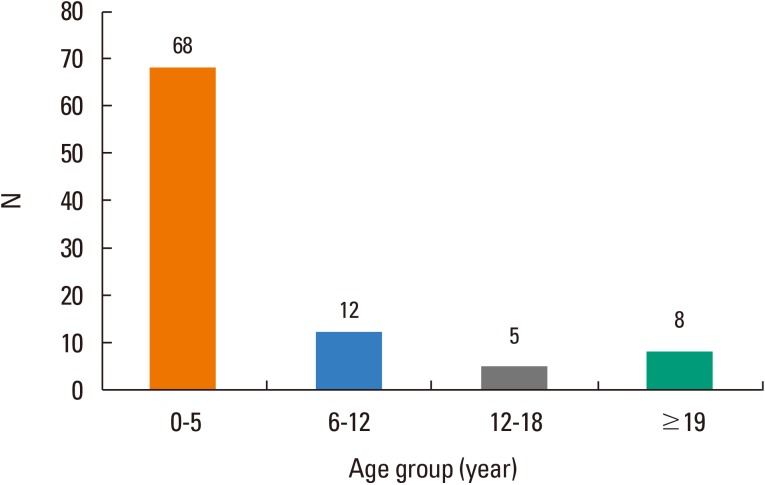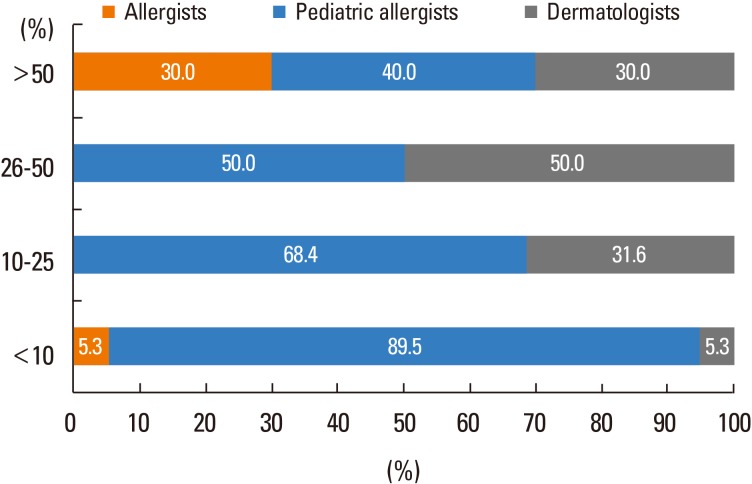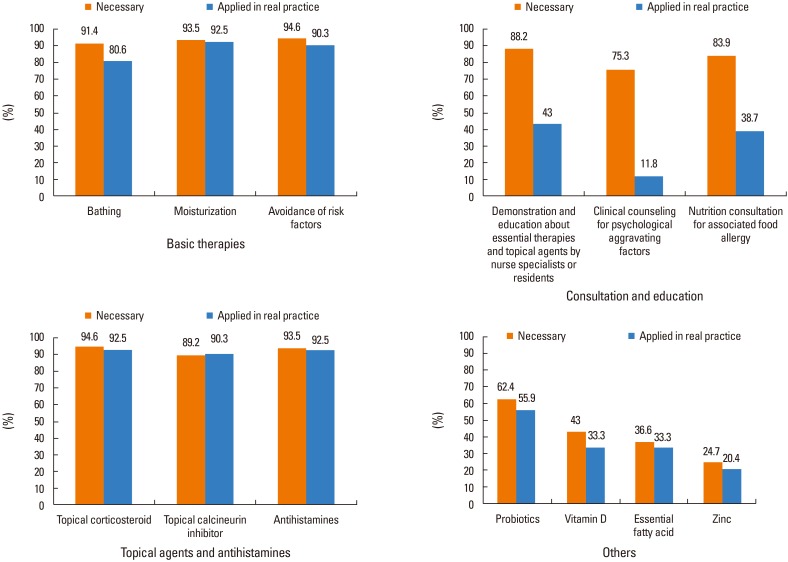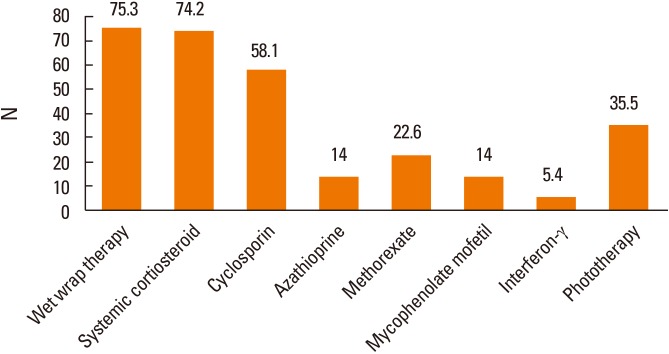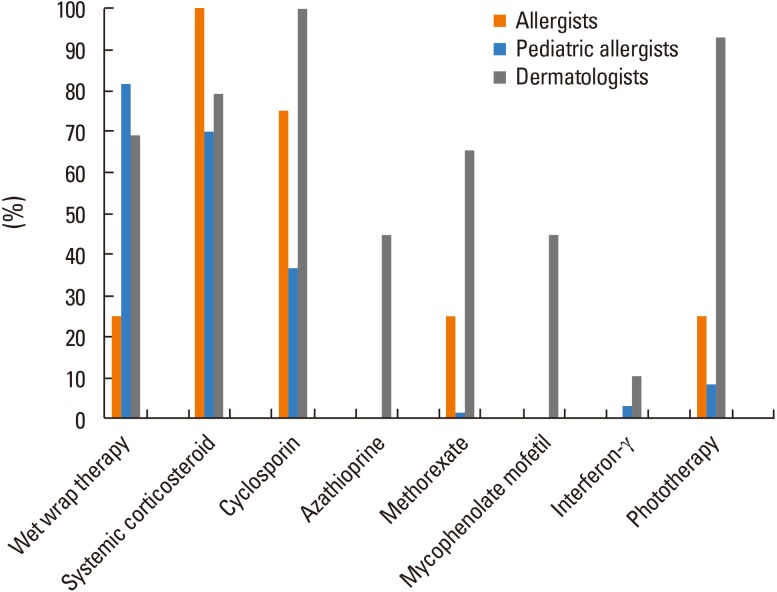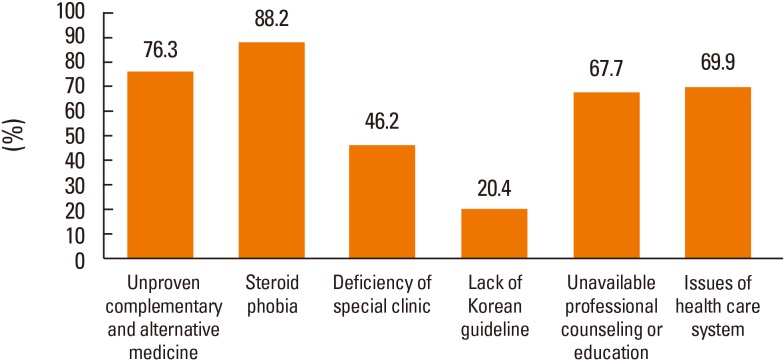Allergy Asthma Immunol Res.
2018 May;10(3):253-259. 10.4168/aair.2018.10.3.253.
Current Management of Moderate-to-Severe Atopic Dermatitis: A Survey of Allergists, Pediatric Allergists and Dermatologists in Korea
- Affiliations
-
- 1Department of Pediatrics, Seoul Medical Center, Seoul, Korea.
- 2Department of Dermatology, Seoul Medical Center, Seoul, Korea.
- 3Department of Pediatrics, Inje University School of Medicine, Seoul, Korea.
- 4Department of Pediatrics, Asan Medical Center, Seoul, Korea.
- 5Department of Dermatology, Chung-Ang University College of Medicine, Seoul, Korea.
- 6Department of Dermatology, Seoul National University College of Medicine, Seoul, Korea. ivymed27@snu.ac.kr
- KMID: 2409060
- DOI: http://doi.org/10.4168/aair.2018.10.3.253
Abstract
- PURPOSE
There is an unmet need for the treatment of moderate-to-severe atopic dermatitis (AD), leading to variation in management strategies. To investigate distinct features and treatment modalities according to physicians' specialties, we collected data on the current treatment approach to moderate-to-severe AD among allergists, pediatric allergists and dermatologists in Korea.
METHODS
This questionnaire-based study was administered to physicians from the Korean Academy of Asthma, Allergy and Clinical Immunology (KAAACI), Korean Academy of Pediatric Allergy and Respiratory Disease (KAPARD), and Korean Atopic Dermatitis Association (KADA).
RESULTS
A total of 93 physicians participated in the study; 64.5% were pediatric allergists and 31.2% were dermatologists. The major patient age groups were "less than 5 years" for 100% of pediatric allergists and "6-12 years old" for 38% of dermatologists. The proportion of patients with moderate-to-severe AD was higher for dermatologists and allergists compared to pediatric allergists. Physicians agreed on the necessity of education including demonstration of basic skin care and application of topical therapies (88.2%), nutritional consultation (83.9%) and psychological counseling (75.3%). However, less than half were able to educate and counsel their patients in real practice. There were noticeable differences in first-line treatment among physician groups. For pediatric allergists, the order of preferred systemic treatment was wet wrap therapy, systemic corticosteroids and oral cyclosporin. Dermatologists ranked cyclosporin, phototherapy, and systemic corticosteroids as first-line treatment regimens. Major reported barriers to proper management were steroid phobia, unproven complementary and alternative medicine, lack of education, and the unreasonable insurance system.
CONCLUSIONS
Our findings suggest there are distinct differences in moderate-to-severe AD treatment according to physicians' specialties. Medical policy changes along with governmental supports are required in order to implement the ideal approach in real practice. For moderate-to-severe AD, a consensus on the approach to optimal management should be reached for the best outcomes, based on further randomized controlled trials.
Keyword
MeSH Terms
Figure
Cited by 2 articles
-
The efficacy of wet wrap therapy in children with atopic dermatitis in a single center
Hyun A Park, Tae Won Song
Allergy Asthma Respir Dis. 2019;7(1):13-21. doi: 10.4168/aard.2019.7.1.13.Clinical Characteristics of Atopic Dermatitis in Korean School-Aged Children and Adolescents According to Onset Age and Severity
You Hoon Jeon, Kangmo Ahn, Jihyun Kim, Meeyong Shin, Soo-Jong Hong, So-Yeon Lee, Bok Yang Pyun, Taek Ki Min, Minyoung Jung, Jeongmin Lee, Tae Won Song, Hye-Young Kim, Sooyoung Lee, Kyunguk Jeong, Yoonha Hwang, Minji Kim, Yong Ju Lee, Min Jung Kim, Ji Young Lee, Hye Yung Yum, Gwang Cheon Jang, Young A Park, Jeong Hee Kim,
J Korean Med Sci. 2022;37(4):e30. doi: 10.3346/jkms.2022.37.e30.
Reference
-
2. Boguniewicz M, Leung DY. The ABC's of managing patients with severe atopic dermatitis. J Allergy Clin Immunol. 2013; 132:511–512.e5. PMID: 23905920.
Article3. Park JS, Kim BJ, Park Y, Lee SY, Kim WK, Kim JE, et al. KAAACI work group report on the treatment of severe/recalcitrant atopic dermatitis. Korean J Asthma Allergy Clin Immunol. 2010; 30:255–270.4. Kim JE, Kim HJ, Lew BL, Lee KH, Hong SP, Jang YH, et al. Consensus guidelines for the treatment of atopic dermatitis in Korea (part II): systemic treatment. Ann Dermatol. 2015; 27:578–592. PMID: 26512172.
Article5. Kim DH, Kang KH, Kim KW, Yoo IY. Management of children with atopic dermatitis. Pediatr Allergy Respir Dis. 2008; 18:148–157.6. Akdis CA, Akdis M, Bieber T, Bindslev-Jensen C, Boguniewicz M, Eigenmann P, et al. Diagnosis and treatment of atopic dermatitis in children and adults: European Academy of Allergology and Clinical Immunology/American Academy of Allergy, Asthma and Immunology/ PRACTALL Consensus Report. Allergy. 2006; 61:969–987. PMID: 16867052.7. Schneider L, Tilles S, Lio P, Boguniewicz M, Beck L, LeBovidge J, et al. Atopic dermatitis: a practice parameter update 2012. J Allergy Clin Immunol. 2013; 131:295–299. 299.e1–299.e27. PMID: 23374261.8. Wollenberg A, Oranje A, Deleuran M, Simon D, Szalai Z, Kunz B, et al. ETFAD/EADV Eczema task force 2015 position paper on diagnosis and treatment of atopic dermatitis in adult and paediatric patients. J Eur Acad Dermatol Venereol. 2016; 30:729–747. PMID: 27004560.
Article9. Kim JE, Kim HJ, Lew BL, Lee KH, Hong SP, Jang YH, et al. Consensus guidelines for the treatment of atopic dermatitis in Korea (part I): general management and topical treatment. Ann Dermatol. 2015; 27:563–577. PMID: 26512171.
Article10. Eichenfield LF, Tom WL, Chamlin SL, Feldman SR, Hanifin JM, Simpson EL, et al. Guidelines of care for the management of atopic dermatitis: section 1. Diagnosis and assessment of atopic dermatitis. J Am Acad Dermatol. 2014; 70:338–351. PMID: 24290431.11. Eichenfield LF, Tom WL, Berger TG, Krol A, Paller AS, Schwarzenberger K, et al. Guidelines of care for the management of atopic dermatitis: section 2. Management and treatment of atopic dermatitis with topical therapies. J Am Acad Dermatol. 2014; 71:116–132. PMID: 24813302.12. Sidbury R, Davis DM, Cohen DE, Cordoro KM, Berger TG, Bergman JN, et al. Guidelines of care for the management of atopic dermatitis: section 3. Management and treatment with phototherapy and systemic agents. J Am Acad Dermatol. 2014; 71:327–349. PMID: 24813298.13. Sidbury R, Tom WL, Bergman JN, Cooper KD, Silverman RA, Berger TG, et al. Guidelines of care for the management of atopic dermatitis: section 4. Prevention of disease flares and use of adjunctive therapies and approaches. J Am Acad Dermatol. 2014; 71:1218–1233. PMID: 25264237.14. Garmhausen D, Hagemann T, Bieber T, Dimitriou I, Fimmers R, Diepgen T, et al. Characterization of different courses of atopic dermatitis in adolescent and adult patients. Allergy. 2013; 68:498–506. PMID: 23452057.
Article15. Bieber T, D'Erme AM, Akdis CA, Traidl-Hoffmann C, Lauener R, Schäppi G, et al. Clinical phenotypes and endophenotypes of atopic dermatitis: where are we, and where should we go? J Allergy Clin Immunol. 2017; 139:S58–S64. PMID: 28390478.
Article16. Park Y. Status of clinical practice on diagnosis and management of atopic dermatitis in Korea: a questionnaire survey of physicians. Allergy Asthma Respir Dis. 2013; 1:257–265.
Article17. Lee DH, Doh EJ, Lee JY, Park Y, Oh JW, Lee MH, et al. Multicenter questionnaires on the current management of atopic dermatitis in Korea. Allergy Asthma Respir Dis. 2016; 4:271–275.
Article18. Lee JH, Son SW, Cho SH. A comprehensive review of the treatment of atopic eczema. Allergy Asthma Immunol Res. 2016; 8:181–190. PMID: 26922927.
Article19. Saavedra JM, Boguniewicz M, Chamlin S, Lake A, Nedorost S, Czerkies LA, et al. Patterns of clinical management of atopic dermatitis in infants and toddlers: a survey of three physician specialties in the United States. J Pediatr. 2013; 163:1747–1753. PMID: 23953725.
Article20. Proudfoot LE, Powell AM, Ayis S, Barbarot S, Baselga Torres E, Deleuran M, et al. The European TREatment of severe Atopic eczema in children Taskforce (TREAT) survey. Br J Dermatol. 2013; 169:901–909. PMID: 23855450.
Article21. Roekevisch E, Spuls PI, Kuester D, Limpens J, Schmitt J. Efficacy and safety of systemic treatments for moderate-to-severe atopic dermatitis: a systematic review. J Allergy Clin Immunol. 2014; 133:429–438. PMID: 24269258.22. Barbarot S, Bernier C, Deleuran M, De Raeve L, Eichenfield L, El Hachem M, et al. Therapeutic patient education in children with atopic dermatitis: position paper on objectives and recommendations. Pediatr Dermatol. 2013; 30:199–206. PMID: 23461685.
Article23. Rubel D, Thirumoorthy T, Soebaryo RW, Weng SC, Gabriel TM, Villafuerte LL, et al. Consensus guidelines for the management of atopic dermatitis: an Asia–Pacific perspective. J Dermatol. 2013; 40:160–171. PMID: 23289827.
Article24. Kim JE, Lee YB, Lee JH, Kim HS, Lee KH, Park YM, et al. Disease awareness and management behavior of patients with atopic dermatitis: a questionnaire survey of 313 patients. Ann Dermatol. 2015; 27:40–47. PMID: 25673930.
Article25. Cho SE, Jeon JE, Cho H, Son DK, Kim HO, Lee SH, et al. Psychological intervention in an integrated health care service for children with atopic dermatitis. Korean J Asthma Allergy Clin Immunol. 2010; 30:100–109.26. Yum HY, Han KO, Park JA, Kang MY, Chang SI, Cho SH, et al. Improvement in disease knowledge through an education program of atopic dermatitis. Korean J Asthma Allergy Clin Immunol. 2012; 32:21–25.27. Aubert-Wastiaux H, Moret L, Le Rhun A, Fontenoy AM, Nguyen JM, Leux C, et al. Topical corticosteroid phobia in atopic dermatitis: a study of its nature, origins and frequency. Br J Dermatol. 2011; 165:808–814. PMID: 21671892.28. Ju HY, Kim HS, Lim SH, Lee SD, Kang H, Kim HO, et al. A survey on the topical steroid prescriptions of dermatologists. Korean J Dermatol. 2009; 47:1004–1011.
- Full Text Links
- Actions
-
Cited
- CITED
-
- Close
- Share
- Similar articles
-
- Current Status of Patient Education in the Management of Atopic Dermatitis in Korea
- The Effect of Antigen Sensitization and Development of Respiratory Allergy Disease on Severity of Atopic Dermatitis
- Measurement of Atopic Dermatitis Disability
- Current Understanding of Atopic Dermatitis
- Update on management of pediatric atopic dermatitis

